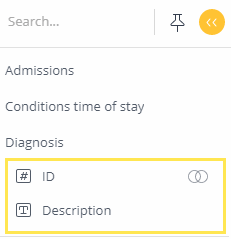Managing Tables and Columns
After you have imported your data into Sisense, it’s time to shape it into a data model that can support your dashboard and provide accurate information to your Viewers.
You can modify your data on two levels: the Table level and the Column level.
Any changes you make to your schema are reflected in the ElastiCube only and do not affect the data in your data source.
For a short video overview of managing the tables and columns in your data model, see below:
Table Level
You can manage tables imported into the ElastiCube through the Navigation Pane or through the table itself in the schema.

The table below describes the menu options available from the Navigation Pane and the table’s menu.
| Icon | Description |
|---|---|

|
Displays a preview of your table’s data. |

|
Rename the table. |

|
Delete a table. |

|
Use Python-based custom code on your data or query new data from any source. |

|
Hide all the columns in a table. Hidden tables are not seen by Viewers, but might be used for custom calculations. Hidden tables are built with the rest of the ElastiCube. |

|
Display all hidden columns in a table. |

|
Duplicate the table. |

|
Hide a table. Hidden tables are not seen by Dashboard Viewers, but might be used for custom calculations. Hidden tables are built with the rest of the ElastiCube. |

|
After dropping columns, you can restore them by clicking Restore all columns. |

|
Restore all dropped columns for a table. |

|
Update a table’s columns if there was a change on the data source without having to add the table again. |

|
Update the connection settings for a table. |

|
Tag a table with metadata that you can use to organize your data and search for it later. See Creating Data Dictionaries for more information. |

|
Allows you to add a custom column to the ElastiCube. See Adding a Custom Column for more information. |

|
Define the build behavior for a specific table. See ElastiCube Build Settings for more information. |

|
Displays related tables together side by side. See Creating and Removing a Relationship between Tables for more information. |
To view your table’s metadata, including its name, path, provider, location, and the number of columns it contains, hover over the table in the schema or in the Navigation Pane.
Column Level
You can manage tables imported into the ElastiCube through the Navigation Pane. Columns that are part of a table are displayed below the table. On the left side of the column is an icon that indicates what type of data is in the column, Numeric, Date, or Text. You can click this icon to convert the column into another data type.
On the right side of the column’s name is an icon that indicates if the column is conducted to another column through a relationship. You can hover over the icon to view more details or disconnect the relationship.
For each column, you can hover over its name to display a menu from where you view the following options for managing your columns:
| Menu Option | Description |
|---|---|
| Duplicate | Duplicates the column in the table. This is useful if you need the same column with some modifications. |
| Rename | Rename the column. |
| Hide | Hide a column to import the data associated with this column, but also make this column unavailable to dashboard designers and viewers. |
| Drop | Remove column from the table. After dropping a column, you can restore it by clicking Restore. |
| Restore | Restore a column that was dropped. |
| Indexed | Index the column data for quicker processing in subsequent builds. |
| Description | Tag a column with metadata that you can use to organize your data and search for it later. See Creating Data Dictionaries for more information. |
| Change Data Type | Change the data type of your column in the ElastiCube. This does not change the column type in the original data source. |
| Is Accumulated by | Enable accumulative behavior for date and integer fields in tables imported by the JDBC connector. |
| Edit Relationship | You can only edit a column’s relationship when the column is connected to another table. |
| Relationships | Displays related columns together side by side. See Creating and Removing a Relationship between Tables for more information. |
.r.